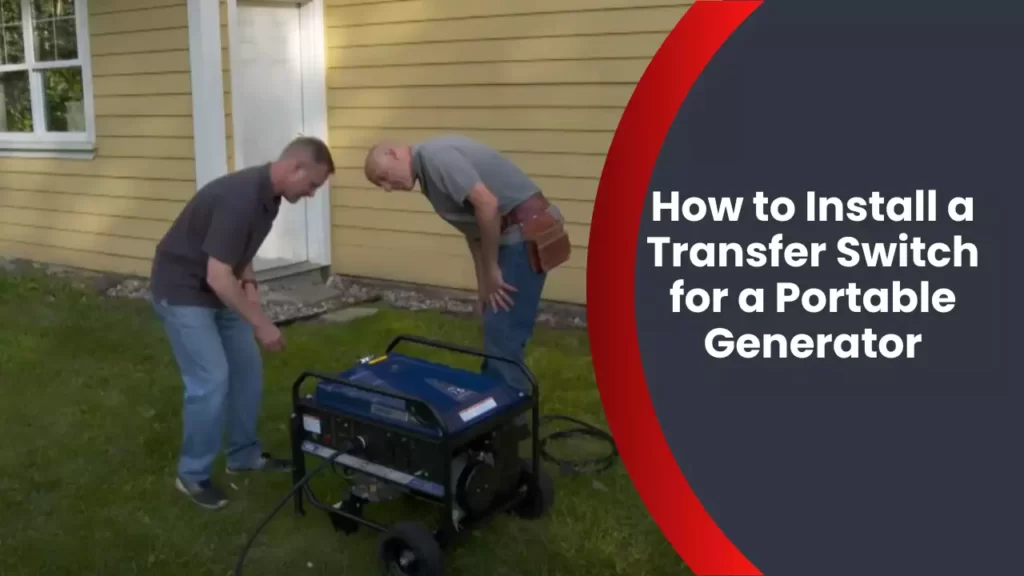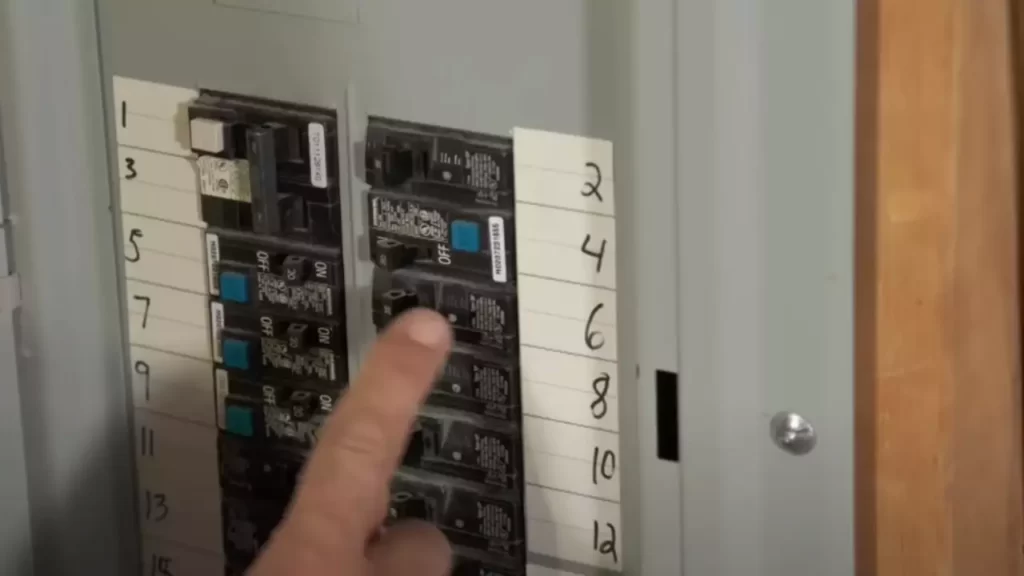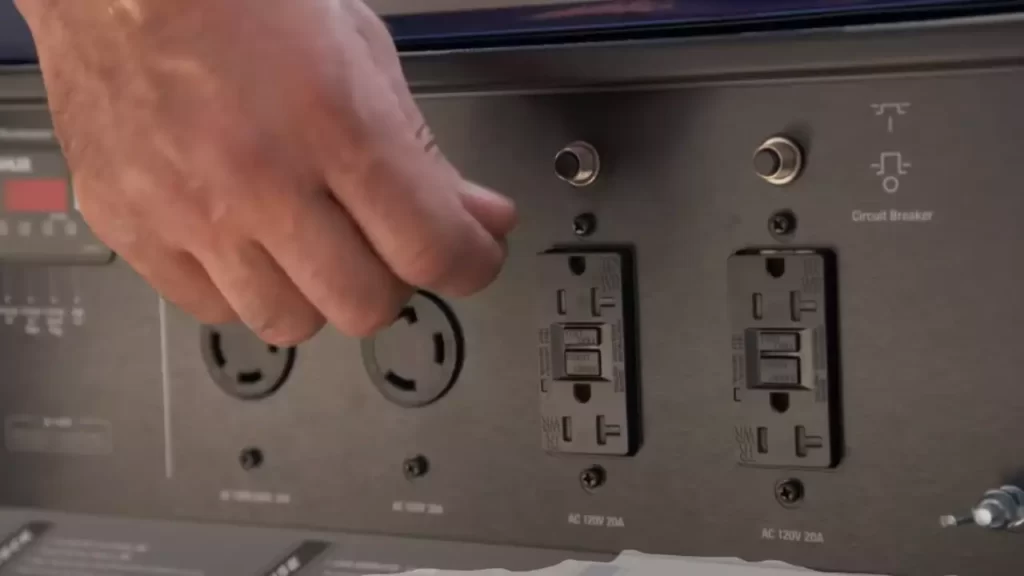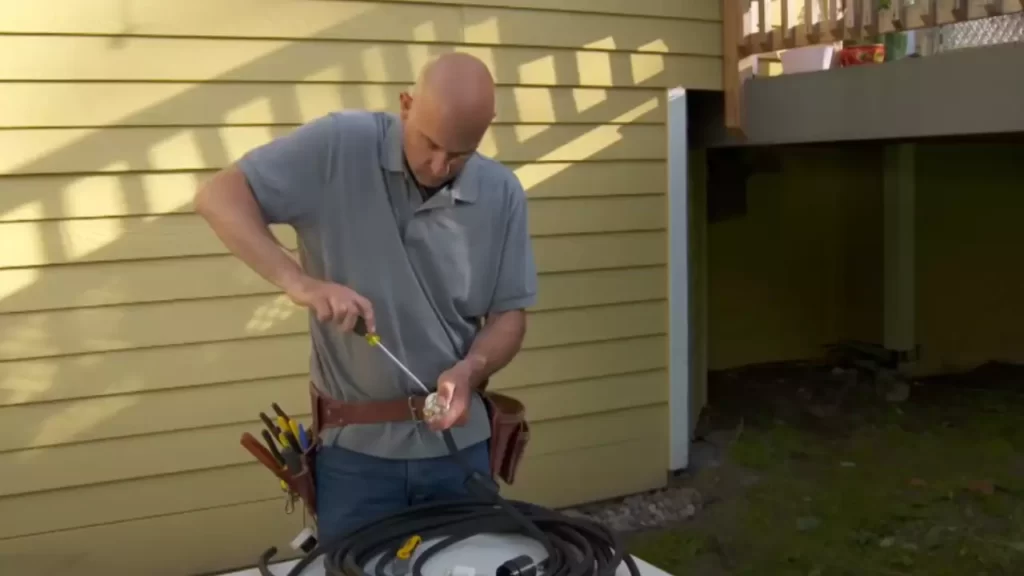To install a transfer switch for a portable generator, follow these steps: turn off the main breaker, mount the transfer switch near the electrical panel, connect the generator to the transfer switch, connect the transfer switch to the electrical panel, and finally, test the system. When installing a transfer switch for a portable generator, it is important to ensure a safe and reliable connection between the generator and your home’s electrical panel.
A transfer switch acts as a bridge, allowing you to safely switch between your utility power and generator power during a power outage. In this guide, we will walk you through the steps to install a transfer switch for your portable generator, ensuring that you can power essential appliances and devices when the grid goes down.
Remember to follow all safety precautions and consult a licensed electrician if you are unsure about any step of the installation process.
Understanding The Importance Of A Transfer Switch
The Importance of a Transfer Switch for Safe Generator Use
When it comes to using a portable generator, safety should always be a top priority. One crucial component that ensures safe and seamless operation is a transfer switch. In this section, we will define and explain the function of a transfer switch, as well as highlight the reasons why it is necessary for safe generator use.
Definition and Function of a Transfer Switch
A transfer switch can be defined as an electrical device that serves as a connector between a portable generator and your home’s electrical system. Its primary function is to transfer power supply seamlessly during a power outage by isolating your home’s electrical circuits from the utility grid and rerouting them to the generator. Essentially, it acts as a barrier that prevents backfeeding, which can be extremely dangerous to utility workers attempting to restore power.
Why a Transfer Switch is Necessary for Safe Generator Use
A transfer switch is not just an optional accessory for your generator, but a critical safety mechanism that ensures safe generator use. Here are a few reasons why it is necessary:
- Protects Utility Workers: By properly isolating your home’s electrical circuits from the utility grid, a transfer switch prevents the dangerous phenomenon of backfeeding. Backfeeding occurs when power flows from the generator into the utility lines, creating a potentially life-threatening situation for workers trying to restore power. A transfer switch eliminates this risk, enabling the safe operation of your generator without endangering anyone attempting to repair the electrical infrastructure.
- Prevents Electrical Fires: During a power outage, there may be fluctuations or surges in the supply of electricity when power is restored. Without a transfer switch, your generator could send electricity directly into the utility lines, resulting in potential damage to appliances, electronics, or worse, causing electrical fires in your home. A transfer switch acts as a crucial barrier, providing a controlled and safe connection between the generator and your electrical system, preventing any damage or fire hazards.
- Safeguards Against Overloads: Another important function of a transfer switch is to protect your home’s electrical system from overloads. It allows you to choose which circuits are powered by the generator, ensuring you remain within its power capacity. This prevents the generator from being overloaded, which can lead to damage or inefficient operation. By properly managing the load, a transfer switch safeguards your generator and your home’s electrical system.
Now that we’ve explored the definition and function of a transfer switch, as well as the reasons why it is necessary for safe generator use, we can understand the vital role it plays in protecting both utility workers and your home’s electrical system. Installing a transfer switch might seem like an additional step, but it is a small investment that guarantees your safety and peace of mind during power outages.

Preparation And Safety Precautions
Before installing a transfer switch for your portable generator, it is crucial to prioritize preparation and safety precautions. This will not only make the installation process smoother but also ensure the safety of both you and your home. In this blog post, we will guide you through the necessary steps to gather the required tools and materials, as well as discuss the safety precautions you need to take before beginning the installation process.
Gathering the necessary tools and materials
Before you start the installation process, it is important to have all the required tools and materials at hand. Here is a list of essential items you will need:
| Tools | Materials |
|---|---|
|
|
Make sure to gather all these tools and materials before you begin the installation process. It will save you time and prevent any unnecessary interruptions.
Safety precautions before starting the installation process
Prior to starting the installation process, it is crucial to take certain safety precautions to ensure that you and your home are safe from any potential hazards. Here are some essential safety measures:
- Turn off the main power supply: Before working with any electrical components, always turn off the main power supply to avoid the risk of electrocution. Locate the main breaker panel and switch off the breaker.
- Wear personal protective equipment (PPE): Protect yourself by wearing safety goggles, gloves, and a dust mask to prevent any injuries or inhalation of harmful particles.
- Read and follow the manufacturer’s instructions: Carefully read through the instructions provided by the manufacturer of the transfer switch. Following the instructions precisely will ensure proper installation and prevent any potential risks.
- Ensure proper grounding: Proper grounding is crucial to protect against electrical shocks. Make sure the grounding rod is securely installed and connected to the transfer switch.
- Check for any potential hazards: Before starting the installation, inspect the working area for any potential hazards, such as water leaks, exposed wires, or damaged electrical components. Address any issues before proceeding with the installation.
- Work in a well-ventilated area: When dealing with electrical components, it is important to have good ventilation to prevent the build-up of potentially dangerous gases. Open windows or use fans to ensure proper air circulation.
By taking these safety precautions, you can ensure a safer installation process and minimize the risk of accidents or damage to your property. Safety should always be the top priority when working with electrical systems.

Steps To Install A Transfer Switch For A Portable Generator
Installing a transfer switch for your portable generator can provide peace of mind in times of power outages. With a transfer switch in place, you can easily and safely switch between utility power and generator power to keep your essential appliances running smoothly. If you are ready to take on this installation project, below are the steps you need to follow:
Step 1: Choosing the right transfer switch for your generator
Before you begin the installation process, it is crucial to choose the right transfer switch that is compatible with your portable generator. Consider factors such as the size of your generator, its power output, and the number of circuits you want to connect to the transfer switch. Consult the generator’s user manual or contact the manufacturer for guidance on selecting the appropriate transfer switch.
Step 2: Identifying the location for the transfer switch installation
Once you have the right transfer switch, the next step is to identify a suitable location for its installation. You will need a dedicated space near your main electrical panel. Ensure the area is easily accessible and allows for proper ventilation to dissipate heat generated by the transfer switch.
Step 3: Shutting off the power supply and disconnecting the main electrical panel
Prior to beginning any electrical work, it is crucial to shut off the power supply to your home. Locate the main electrical panel and turn off the main breaker. Use a voltage tester to ensure there is no live electricity present before proceeding. Once confirmed, disconnect the main electrical panel from the utility power source to ensure safety during the installation process.
Step 4: Mounting the transfer switch and connecting the generator inlet box
Mount the transfer switch in the designated location, following the manufacturer’s instructions. Ensure it is securely fastened to the wall or surface. Next, connect the generator inlet box to the transfer switch using the appropriate wiring method as specified by the manufacturer. This box will serve as the connection point for your portable generator.
Step 5: Wiring the transfer switch to the main electrical panel
With the transfer switch and generator inlet box in place, the next step is to wire the transfer switch to the main electrical panel. This should be done meticulously, following the wiring diagram provided by the manufacturer. Take note of the different colored wires and their designated connections. When completing the wiring, ensure all connections are tight and secure.
Step 6: Testing the transfer switch and ensuring proper functionality
Once the wiring is complete, it is essential to test the transfer switch before relying on it during an emergency. Restore the power supply to your home and start the generator. Flip the transfer switch to the generator position and check if the designated appliances receive power. Test each circuit individually to ensure the transfer switch functions correctly. If any issues arise, consult a professional electrician.
By following these steps, you can successfully install a transfer switch for your portable generator. Remember, if you are unsure about any step or not confident in your electrical skills, it is always best to seek professional assistance for a safe and proper installation.

Common Challenges And Troubleshooting Tips
When it comes to installing a transfer switch for a portable generator, there are a few common challenges that you might encounter along the way. But don’t worry, with the right troubleshooting tips, you’ll be able to overcome these hurdles and successfully complete the installation process.
Potential challenges during the installation process
During the installation process, it’s not uncommon to face a few challenges that may slow down your progress. To ensure a smooth installation experience, it’s important to be aware of these potential challenges and know how to tackle them:
- Wiring complexity: One of the biggest challenges when it comes to installing a transfer switch is dealing with the complexity of the wiring. It can be confusing to figure out which wires go where and how to connect them properly. To overcome this challenge, it is recommended to carefully read the installation manual and follow the step-by-step instructions. Additionally, labeling the wires can be incredibly helpful in ensuring that you connect everything correctly.
- Sizing the transfer switch: Another challenge that many face is determining the right size for their transfer switch. Choosing a transfer switch that is too small can lead to overloaded circuits, while choosing one that is too large can be a waste of money. To overcome this challenge, it is crucial to calculate the total power requirements of the appliances and devices you want to power during an outage. Refer to the manufacturer’s specifications and consult with an electrician if needed to determine the appropriate size.
- Obtaining proper permits: Installing a transfer switch usually requires obtaining permits from the local authorities. This process can be time-consuming and may require submitting intricate paperwork. To tackle this challenge, it is important to research and understand the permit requirements for your specific location beforehand. This ensures that you have all the necessary documentation and can expedite the permit approval process.
- Dealing with limited space: Limited space can also pose a challenge when it comes to installing a transfer switch. Some homeowners may find it difficult to allocate a designated area for the switch within the available space. However, with a bit of creativity and careful planning, it is possible to find a suitable location. Installing the transfer switch on an exterior wall or exploring compact options can help overcome this challenge.
Troubleshooting common issues with a transfer switch
Even with careful installation, you may still encounter some common issues with your transfer switch. Here are a few troubleshooting tips to help you address these problems effectively:
- No power to your appliances: If you find that your appliances are not receiving power despite the transfer switch being properly installed, check the circuit breakers and ensure they are in the “on” position. It’s possible that the breakers have tripped and need to be reset.
- Partial power loss: If you experience a partial power loss, where only some appliances are working, it could be due to a loose connection or a faulty wire. Double-check all the connections and tighten any loose wires. If the issue persists, it is recommended to seek professional assistance to avoid any potential safety hazards.
- Generator not starting: If your generator fails to start, check the fuel level, oil level, and battery condition. Make sure there are no clogs in the fuel system and the spark plug is clean. If necessary, refer to the generator’s manual for specific troubleshooting steps.
- Faulty transfer switch: In rare cases, you may encounter a faulty transfer switch. If you suspect that your switch is not functioning correctly, consult the manufacturer’s troubleshooting guide or contact their customer support for assistance. In some instances, you may need to replace the switch altogether.
By being aware of these potential challenges and armed with troubleshooting tips, you’ll be better prepared to tackle any issues that may arise during the installation of a transfer switch for your portable generator. Remember to follow all safety precautions and consult with professionals if needed to ensure a successful and reliable setup.

Maintaining And Caring For Your Transfer Switch
Regular maintenance of your transfer switch is crucial for ensuring its optimal performance and prolonging its lifespan. By implementing a few simple tasks, you can keep your transfer switch in excellent condition, ready to seamlessly switch power sources when needed.
Regular maintenance tasks to prolong the lifespan of the transfer switch
Performing regular maintenance on your transfer switch is relatively straightforward and can prevent potential issues from arising. Here are some essential tasks to include in your maintenance routine:
- Inspecting for any visible signs of damage
- Cleaning the transfer switch
- Testing the transfer switch regularly
- Tightening connections
- Keeping a record of maintenance
Regularly check your transfer switch for any visible signs of damage, such as frayed wires, loose connections, or corrosion. If you notice anything unusual, it is crucial to address it promptly to prevent further complications.
Keep your transfer switch clean by removing any dust, dirt, or debris that may accumulate on its surfaces. Use a soft cloth or brush to gently wipe away any particles. This helps prevent obstructions that could interfere with the switch’s proper functioning.
To ensure the transfer switch is working correctly, it’s essential to test it regularly. Follow the manufacturer’s guidelines for conducting tests and make note of any issues or discrepancies. By doing so, you can identify and resolve any potential problems before they escalate.
As part of your maintenance routine, it’s recommended to check and tighten any loose connections within the transfer switch. Loose connections can lead to electrical arcing or overheating, potentially damaging the switch or other connected devices.
Maintaining a record of your transfer switch’s maintenance activities can be beneficial for tracking its performance and scheduling future maintenance tasks. Create a logbook or digital document to record dates, tasks performed, and any observations made during maintenance.
Signs of a malfunctioning transfer switch and how to address them
While regular maintenance can minimize the risk of problems, it’s essential to be vigilant for any signs of a malfunctioning transfer switch. Early detection allows for timely repairs or replacement, preventing potential disruptions to your generator’s functionality. Watch out for the following indicators:
- Flickering lights or intermittent power loss
- Unusual noises or burning smells
- Failure to switch power sources
If you notice frequent flickering lights or experience intermittent power loss when using your generator, it could indicate a problem with the transfer switch. In such cases, hiring a professional electrician to diagnose and address the issue is advisable.
Strange noises or burning smells emanating from the transfer switch might indicate internal damage or potential electrical issues. In such instances, it is crucial to immediately power off the generator, disconnect it, and seek professional assistance for inspection and repairs.
If your transfer switch fails to switch power sources when the generator is running or vice versa, it could be a sign of a malfunction. First, ensure that the generator is working correctly. If the problem persists, contacting a qualified electrician can help identify and resolve the underlying issue.
Maintaining and caring for your transfer switch properly can go a long way in ensuring its longevity and dependable functionality. Regular inspections, cleaning, testing, and prompt resolution of any issues will help keep your transfer switch in outstanding condition, ready to assist you in times of power outages.
Conclusion: Enjoying The Benefits Of A Transfer Switch
Conclusion: Enjoying the Benefits of a Transfer Switch
After successfully installing a transfer switch for your portable generator, you can now fully embrace the many benefits that come with this essential equipment. It provides a seamless and safe way to connect your generator to your home’s electrical system during power outages, ensuring uninterrupted power supply to critical appliances and circuits. In this concluding section, we will recap the key benefits of having a transfer switch and emphasize the importance of following safety guidelines throughout the installation process.
Benefits of having a transfer switch for your portable generator
Having a transfer switch for your portable generator offers several advantages, making it a wise investment for homeowners. Let’s take a closer look:
- 1. Safety: The primary benefit of a transfer switch is increased safety. It eliminates the risk of backfeeding, which can be dangerous for both utility workers and neighboring homes. Backfeeding occurs when power from the generator flows back into the utility lines, potentially causing electrical shock or fires.
- 2. Convenience: With a transfer switch in place, you no longer need to manually connect appliances or extension cords to the generator during a power outage. The switch seamlessly transfers power from the utility to the generator and back, ensuring uninterrupted power supply to your essential circuits.
- 3. Protection for appliances: By using a transfer switch, you can protect your appliances from damage caused by power surges or fluctuations when the utility power is restored. The switch ensures a stable and regulated power supply to your home, safeguarding your valuable electronics and appliances.
- 4. Peace of mind: A transfer switch provides peace of mind during emergencies. It eliminates the hassle of manually managing power connections and allows you to focus on other essential tasks, knowing that your generator will automatically power your home’s essential circuits.
Recap of the installation process and the importance of following safety guidelines
Installing a transfer switch for your portable generator is a straightforward process, but it requires careful adherence to safety guidelines to ensure a successful and safe installation. Here is a recap of the general steps involved:
- Choose the right transfer switch based on your generator’s capacity and the circuits you want to power.
- Turn off the main electrical supply to your home.
- Mount the transfer switch near your electrical panel and connect it to the utility power lines and your generator.
- Connect the critical circuits you want to power during an outage to the transfer switch.
- Double-check all connections, ensuring they are secure and properly tightened.
- Test the transfer switch to ensure it works as intended, following the manufacturer’s instructions.
- Restore power to your home’s electrical panel and enjoy the peace of mind that comes with a reliable backup power solution.
Remember, safety should always be a top priority when working with electrical systems. Follow all safety guidelines provided by the manufacturer and consult a licensed electrician if you have any doubts or concerns. Make sure to use the appropriate safety equipment and tools throughout the installation process.
Frequently Asked Questions
Can I Install My Own Generator Transfer Switch?
Yes, you can install your own generator transfer switch. It is important to follow safety guidelines and electrical codes to ensure proper installation. Seek advice from a certified electrician to ensure it is done correctly.
Can You Install An Automatic Transfer Switch With A Portable Generator?
Yes, you can install an automatic transfer switch with a portable generator. When the power goes out, the transfer switch automatically switches your home’s electrical load from the main power grid to the generator. It ensures a seamless transition and protects your appliances from power surges.
How Much Does It Cost To Install A Manual Transfer Switch For A Portable Generator?
The cost of installing a manual transfer switch for a portable generator varies but typically ranges from $500 to $1,500.
How To Install Manual Transfer Switch For Portable Generator?
To install a manual transfer switch for a portable generator, follow these steps: 1. Turn off the power supply. 2. Connect your generator to the transfer switch. 3. Connect the transfer switch to your electrical panel. 4. Update the circuits that will be powered by the generator.
5. Test the system to ensure it functions correctly. Remember to consult a professional if you’re unsure about any step.
Conclusion
Installing a transfer switch for a portable generator is a crucial step in ensuring a smooth power transition during emergencies. By following the step-by-step process outlined in this guide, you can safeguard your electrical system and protect your appliances. Remember to seek professional help if you are unsure about any aspect of the installation process.
With a transfer switch in place, you can have peace of mind knowing that you’ll have reliable power whenever you need it. Stay prepared and stay safe!
